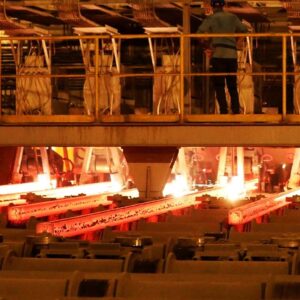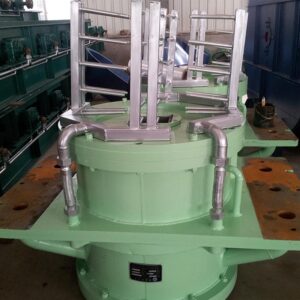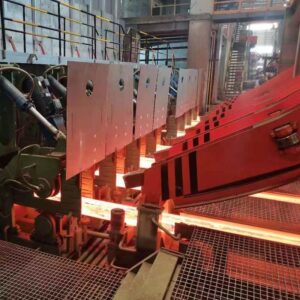Description
Continuous Casting Tundish
Continuous casting tundish and rolling equipment are used to receive molten steel from ladles and distribute it to each flow of crystallizers. It also has the functions of pressure stabilization, storage, and tundish metallurgy.
Tundish metallurgy refers to the process of improving and controlling the quality of steel in the tundish of continuous cast steel. It is a key link in the production process from the smelting and refining of steel to the production of continuous casting billets to ensure the quality of billets.
It is an important part of the production process from the smelting and refining of steel to the production of continuous casting billets to ensure the quality of billets. In the early days of continuous casting steel development, tundish was used only as a storage and distributor of molten steel.
The concept of “tundish metallurgy” was put forward at the beginning of the 1980s. It has gradually become a hot topic in the past 20 years and formed technical measures for practical application in production.
It includes the design of tundish structure, steel flow control technology, restraint of secondary oxidation of steel, control of refractory material and covering slag, control of temperature and composition during operation of replacing ladle, argon blowing cleaning, filter addition, heating of tundish (steel water), micro-alloying in tundish and circulation application of hot tundish.
Continuous Casting Tundish Structure
Tundish generally consists of a tundish body, tundish cover, water nozzle, and flow control device. The shell of the tundish body is usually welded with a 12-20mm thick steel plate, which requires sufficient rigidity. The structure of the tundish body shall be deformed and lined with refractory materials when pouring, handling, slag cleaning, and tumbling under high temperatures for a long time.
The tundish cover is welded with a steel plate and lined with refractory material. The cover is equipped with steel flow pouring holes, plug rod holes, and heating holes, which are mainly used for insulation and reducing heat loss of steel.
Generally, the cover of a small capacity tundish is integral and the large capacity can be combined into several parts. The capacity of the tundish is an important parameter of the tundish.
Generally, 20%~40% of the steel volume is taken as the capacity of the tundish. The value of small capacity is taken as the value of large capacity and that of large capacity is taken as the value of small capacity. In order to guarantee the quality of billet produced by multi-furnace continuous casting, the casting time of molten steel stored in the tundish must be longer than that required for changing the tundish.
The shape of the tundish is rectangular, triangular, elliptical, V-shaped, T-shaped, H-shaped, etc., which can be selected according to the workshop conditions and the type of casting machine.
According to its structure, it can be roughly divided into slab continuous casting and small billet continuous casting. Two water outlets are generally arranged at the bottom of the tundish for slab continuous casting. In order to meet the needs of multi-flow casting, several nozzles such as 4, 6, and 8 nozzles are arranged along the length of the tundish.
Parameter
Parameter of Continuous Caster Tundish
|
Strands Number per Tundish: Max. 8 strands
|
|
Working capacity of liquid steel: maximum 45 tons
|
|
T-section or triangular section, different shapes of retaining wall and stabilizer are simulated and configured by steel flow field to control the difference of casting temperature of each flow of steel, reduce the scouring of steel on Refractories in tundish and the entrapment of slag.
|
|
Installation and design of relevant equipment according to user’s requirements, such as preheating and baking device, plug rod mechanism, quick-change device of fixed diameter nozzle (including accident gate), continuous temperature measuring device, etc.
|
|
Provide material for refractory masonry
|
|
Matching Design and Manufacture of Packing Mold for Lining
|
|
Supporting design and manufacture of storage, centering, and tipping devices for tundish
|
The Function of Continuous Casting Tundish
The Function of the tundish can be summarized into five items:
(1) Diversion. For a multi-strands continuous casting machine, the molten steel is diverted by a multi-nozzle tundish.
(2) Continuous casting. In multi-furnace continuous casting, the molten steel stored in the tundish acts as a link when changing the ladle.
(3) Pressure reduction. As the height of the tundish is lower than that of the ladle, it can be used to stabilize the molten steel and reduce the scouring of the steel flow on the solidified shell in the crystallizer.
(4) Protection. By means of a covering agent for the liquid level of tundish, a long water nozzle, and other protective measures, contamination of molten steel in tundish can be reduced.
(5) Purify liquid steel. Non-metallic inclusions in molten steel have the opportunity to float and separate.
Customized Continuous Caster
We can design and manufacture the latest continuous casters according to the customer’s steelmaking capacity, billet size, steel grades, and site conditions. It can also be used for manufacturers who already have continuous casting equipment.
Customization Scope
Arc radius of casting machine: R2. 5-10m
Blanks: square billet, round billet, slab, beam blank
Continuous casting billet material: low carbon steel, low carbon alloy steel
Design production volume: first-class 100,000 tons, second-class 200,000 tons, third-class 300,000 tons
Service
We can provide foundation layout and layout drawings
We will send engineers to your factory to install and debug machines and provide reliable after-sales service.
Competitive price and excellent quality
Our machines are easy to operate and maintain
Less investment
Stable performance
Products can be customized according to different needs
Production capacity can be adjusted according to customer requirements
Low energy consumption








